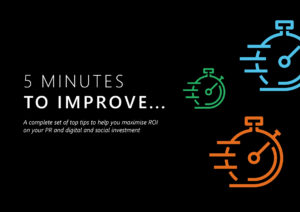By Hannah Buckley, Head of Content
A popular topic of discussion in the world of PR and marketing is the role of content and the question ‘is content still king?’ is one that comes up from time to time. For us at Whiteoaks, there is no doubt that content is still king. After all, what else could you rely on to do everything from building trust with your audience and guiding customers through the sales funnel, to demonstrating your expertise and boosting brand awareness?
Content is multifaceted and, with a solid content strategy directing your efforts, every single piece can open you up to a world of opportunity.
No matter your business objectives, whether it’s increasing brand awareness, community engagement, lead generation, or anything else, a well-executed content strategy will set the stage for success and help you achieve your goals.
When it comes to content marketing, for example, those who have a strategy in place are much more likely to be in the category of successful companies, according to a recent Statista report.
So how does that play out in the real world? With 70% of B2B decision-makers saying that content marketing has helped them achieve their lead generation goals, let’s see how you can align your content strategy with this goal…
#1 Define your target audience
If you’re aiming to generate leads, the starting point is ensuring you can reach your intended audience. This means developing personas which encapsulate who those audiences are so that their needs and wants are front of mind when it comes to what you create and how you share it. This will help to ensure your content not only reaches them but also resonates.
By segmenting your audience based on these personas, you can tailor your content more precisely to meet their different needs. As experts in your industry, you understand the challenges your customers are facing, therefore, you can align certain pain points to different segments and create content with the intention of helping them to overcome those issues.
Taking this approach will also help to cement your identity as an authority within your industry.
#2 Nurture the relationship
A vital part of content marketing is understanding that different content is needed for each of the different stages of the buyers’ journey. After all, the requirements and intentions of someone at the awareness stage are likely to be very different to those of someone who is almost at the point of making a decision about whether to buy from you. As such, this should be a key consideration of your content strategy to ensure you influence leads and nurture the relationship.
Mapping out the different stages of the journey and determining what types of content are right for each stage, whether that’s evergreen content you’ve produced previously or new content you need to create, will help you with this and will be crucial to achieve your ultimate goal of turning a lead into a customer.
#3 There’s more than one channel
From print media, such as trade publications, and third-party websites, to social networking sites and your own blog, there are a great many channels on which you can now share content in its many guises.
By understanding how your target audience interacts with each channel, the types of content that perform well on each and what they want from content, you can share content to greater effect.
Some channels may be more effective at generating leads at different points in your campaign. By monitoring this, you can ensure your efforts are optimised and each channel is used as effectively as possible.
#4 Don’t stop once you convert…
A vital point to remember about using content for lead generation is that engagement shouldn’t stop purely because you’ve managed to convert. Rather, content is key to retention.
Your customers are also an excellent source of content as once you’ve built that relationship you can approach them for testimonials which you can then feed into your content strategy and use for future lead generation. With research finding that testimonials can help businesses generate 62% more revenue from every customer, it’s certainly a valuable type of content to have at your disposal!
As you can see, when it comes to content, the possibilities are endless and armed with an expertly crafted and well-executed content strategy you can make the most of every opportunity it presents.


